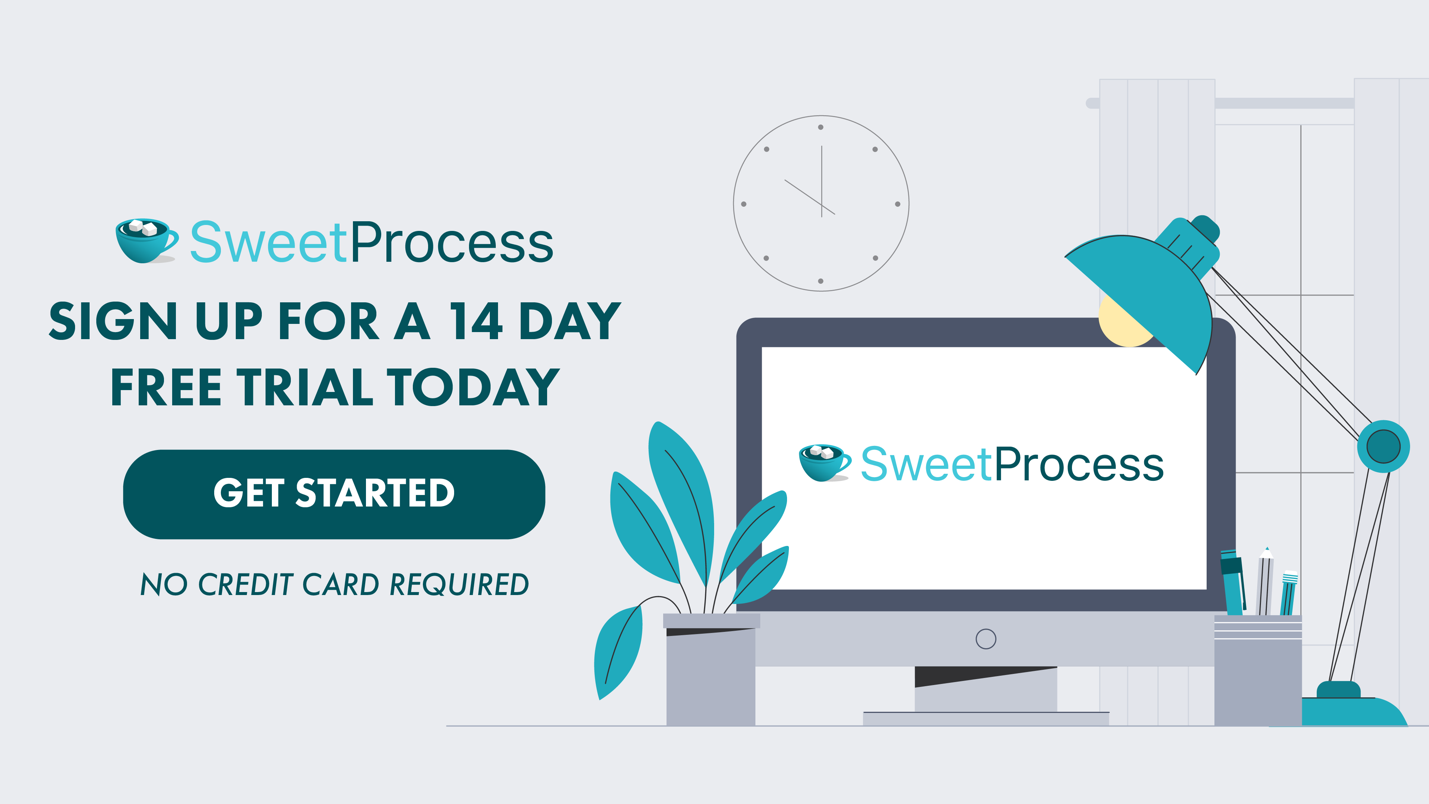Last Updated on March 13, 2025 by Owen McGab Enaohwo
![Law Firm Management: [Best Practices, Tips, and, Tools]](https://www.sweetprocess.com/wp-content/uploads/2025/02/law-firm-management.jpg)
Law firm management is not something you learn in law school. This is unfortunate because even as a solo lawyer, you run a business with demands beyond your skills.
Such demands become more pressing once you create a law firm. You may expect all your recruits to perform according to the job description because you hired the best. However, working independently and as part of a team are very different.
Left on their own, it is unlikely that every attorney in your team will follow similar methods of onboarding and dealing with clients, invoicing them, giving a legal notice or legal advice, litigation services such as securities litigation, disputes resolution, archiving the case files when the proceedings are over, or even preparing for the case and presenting it in court.
Law firm management is a serious job, but it doesn’t have to be complicated.
In this article, we’ll show you the functional steps to growing your legal firm simply and efficiently.
Sign up for a full version trial of SweetProcess for 14 days. No credit card is required.
What You’ll Learn In This Guide:
The Importance of Law Firm Management
Law Firm Management Best Practices & Tips
Tools for Effective Law Firm Management
How to Manage Your Law Firm With SweetProcess
How to Measure Success in Law Firm Management
Manage Your Legal Firm Effectively Using SweetProcess
What Is Law Firm Management?

Law firm management is running the firm as a business. Even a solo practice is a business, but if several people work for you, things require more stringent management. Management is defined by the kind of processes you have in place for a smooth workflow.
You have management when there’s a system for marketing, branding, hiring, onboarding, financial services, employee conduct and training, and work distribution (among other myriad requirements).
But of course, that system must be such that it can be implemented as intended and not something that only looks good on paper.
Let’s discuss some of the more important aspects of running a law firm, which requires management through a well-defined system.
The Importance of Law Firm Management

We have shortlisted four indispensable aspects of law firms, and we’ll explain why careful management is required even with qualified personnel working for you.
Ensuring Client Satisfaction
This is simple enough, isn’t it? All you need is to win the cases, extend a warm welcome to your clients at onboarding, answer their questions before they ask, and so on.
And yet, it is common to observe that the same thing does not satisfy everyone.
What kind of a win are we talking about? Was it one that the client imagined they would get, or was it the one that you were able to explain to them that was feasible?
How do you make a welcome “warm?” A smile? A few words? Something that reassures the client without being overbearing?
Absolutely.
But you will want to work on those aspects.
If possible, you can talk to other firms or hire an expert from the hospitality industry if that’s what it takes. Just so long as you don’t take client satisfaction (or first impressions) for granted.
A structured client intake form can help set expectations early, ensuring that clients feel heard and understood from the outset. By designing your client intake form carefully, you align their expectations with what’s realistically achievable, reducing misunderstandings and improving satisfaction.
Without having to create one yourself, you can use any of these client intake form templates to collect necessary information to ensure client satisfaction.
And remember that many people find it overwhelming to have their minds read (and their unasked questions answered).
Logically, you want someone who knows the law, understands people, can communicate well, and knows when to keep their mouth shut when dealing with clients. In the “communicate well” category, they also have to understand how to communicate bad news.
Now, assume you have at least three such gems on your team. Do they act on their own?
While you’ll want to leverage their unique talents, you’ll also want them to represent your firm’s image. So, you’ll have someone they report to so that their way and the firm’s way remain aligned.
Optimizing Revenue Streams
Optimizing revenue streams is possible in several ways, but what is your firm’s overarching policy on this aspect? Have you listed what must never be done and if exceptions are allowed under certain circumstances? You should because that ensures no one crosses boundaries—and you have one less thing to worry about.
For example, if your current internet service provider is good and you’ve had a stable relationship with them, would you be willing to replace them with someone else offering a better deal?
Proper law firm management will have already determined whether you are to value relationships over cost and, if so, up to what extent. Once these details are in place, you will have fewer queries to answer and more work done.
Compliance and Risk Management

This is a huge area and of vital importance. Ideally, you should have a dedicated team looking after this in addition to a good insurance provider who knows exactly how to keep you protected.
For the insurance part, you could just ask around and choose from among the most trustworthy ones. Internal expertise and monitoring are where your management skills come into play.
You should have policies regarding your employee handbook, monitoring state-level updates, periodic compliance of employees as soon as something important is introduced, and a system to get all of this done efficiently.
If not, you’ll be hard-pressed to get any work done, worrying about whether the firm may be liable to prosecution for something someone missed.
Actually, inviting that kind of scenario will most likely force you to go out of business soon enough.
Improving Team Efficiency and Morale
An unhappy workforce equals inefficient workflow because hardly anyone is putting in their best effort, and they want to leave for a better option.
What is most unfortunate is that this could happen even if you are not a taskmaster.
You may think you have provided your employees with an excellent, airy workspace (designed by the best architect), but what if someone cannot bear too much daylight consistently and doesn’t know what to do about their problem?
Even if you are fair with promotions, bonuses, and workload distribution, what if discontent is not reaching you? Worse, what if there are real reasons for the discontent you are unaware of?
It may be easy for you to assume that your expectations for collaboration and cooperation among team members will be fulfilled, but what if they cannot agree on how best to achieve that?
It is not enough to have everything in place—you must fine-tune it to your exact requirements. And that requires management. Keeping communication channels open will consume a major portion of the management effort in this case. For that, you will want to have very clear procedures about those channels.
Law Firm Management Best Practices & Tips

Any “best practice” is as good as its fit inside your unique system. Sometimes, you’ll want to leave the proverbial fence alone; other times, you should vigilantly pursue constant improvement or even radical change, as needed. Let’s look at some of the more important administrative aspects of law firm management to understand this better.
Develop a Clear Goal
A well-defined goal is necessary for any successful business conscious of its brand image. A company is for making money, but if you project nothing beyond that, customers may not consider you worth their trust—and money.
However, if you wish to draw the line somewhere, if you know that you will never defend an accused of a certain category of crime if you find out they actually committed it, then make it a rule. This way, every attorney in your firm and every paralegal knows which clients to investigate with extra caution before accepting their brief.
A clearly defined goal helps you project a public image with your legal profession, and it sets boundaries for your internal workflow. Effectively, it clarifies your intent to your prospects and saves you time by outlining clear guidelines, particularly on what to avoid.
Leverage Data for Decision-Making
Unless your life depends upon thinking on your feet, it is best to consider data when making a decision. You do know how important precedents are in winning a case. And what is precedent if not data?
Hard facts and figures are an excellent foundation upon which wisdom and instinct can act. There is no replacing extensive and efficient research.
The general protocol is for paralegals to do the actual research based on specific guidelines and for the associates to sift through the data to present their insights to the senior lawyers, who will then convey their (fact-based, data-driven) opinions to the senior partners or the higher management.
In fact, the protocol is the same even if the decision-making step were to start and end with a paralegal: research > sifting through data > gaining insight > forming an informed opinion.
Please include this crucial step in your management if you value your legal operations’ reputation.
Prioritize Client-Centric Practices
If you give someone an appointment for 3:00 in the afternoon, do they have to spend more than 15 minutes in the waiting area? Do you serve refreshments while they are waiting? Are they greeted with a smile and by their name at the door, or do they have to walk to a desk where very professional and impassive individuals politely ask them to wait?
People come to you because they are in some kind of distress, hoping for relief. If you prioritize making them feel comfortable, you will have happy clients and free publicity—of the good kind. Those with a business that requires a retainer service will likely choose you without exploring further options.
If you are serious about law firm management (as opposed to running a business that makes money), developing optimal client-centric practices is not optional.
Get Your Employees on Board

Unless they are partners, your employees are your firm’s least-paid individuals. Sure, you may be paying them better than competitive salaries, but they also know that the pay difference is more than substantial. You could argue that resentment about this is neither logical nor professional, and you’d be right. However, resentment does not follow logic.
A straightforward way to preempt resentment and promote work culture is to make everyone feel that they are contributing and that their contribution is appreciated. We are not talking about bonuses or raises. That should come as a matter of course. What is more important is for your employees to feel that your firm is also theirs.
It is a good idea to involve all employees in whatever decision-making process makes sense. This will also show them that the seniors or the managerial staff don’t just sit around delegating work and criticizing afterward—they also work.
Senior staff may easily achieve this by training junior staff and showing them hands-on (instead of barking orders) how to do things. Constructive public appraisal sessions, where contributions of all partners and employees receive discussion, appreciation, and constructive criticism followed by encouragement, are also effective.
Regardless of your approach, getting your employees on board and promoting a healthy work culture pays dividends and should be among your law firm management priorities.
Foster Collaboration and Communication
If your employees refuse to collaborate with each other when required, your firm loses.
Your firm loses if your employees cannot communicate with you when needed.
If your managerial abilities can remove or minimize barriers to collaboration and communication, your entire firm will function as a single, efficient unit. If not, there will be pockets of resentment and wasted resources that will fester.
Analyze Performance
Analyzing performance is a given, of course. In addition to the public appraisal to foster goodwill and collaboration, it makes sense to hold private sessions where necessary. For them to be effective and not merely intimidating, you’ll need data to base your queries and recommendations upon.
Effective law firm management requires knowing each employee’s strengths and weaknesses and how to train or reassign them for greater contribution. You may have a young associate who thinks their specialty is closing. However, it is also possible that they could perform even better as a trial lawyer.
Discovering talents from within your existing staff is a part of good management. In a similar scenario for a paralegal, you could even think about sponsoring their training for a law degree. Or not.
What is important is that you have the data to make informed decisions. And for that, performance analysis has to be a dedicated department in your law firm management structure.
Tools for Effective Law Firm Management
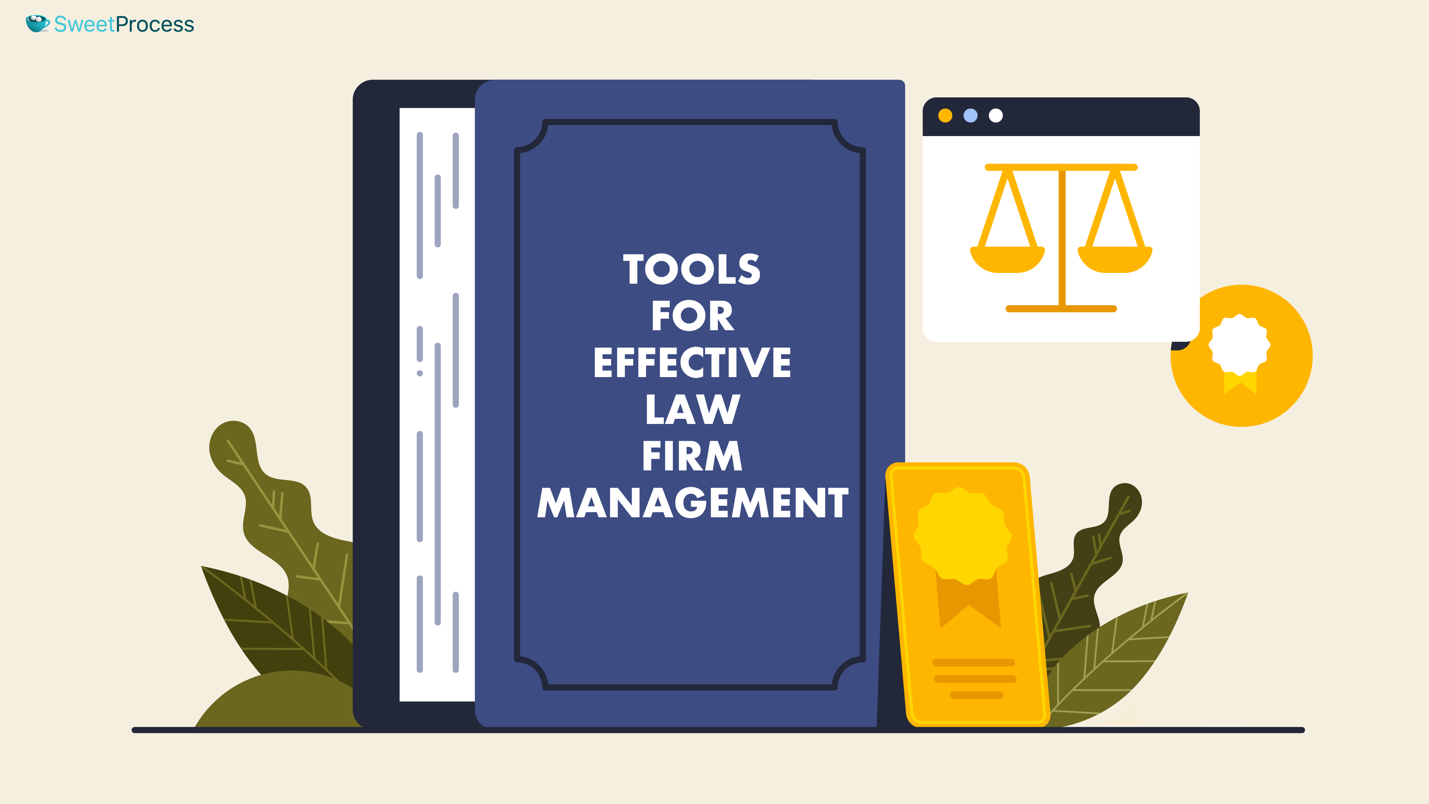
If the administrative structure does not behave like the efficient and credible command center everyone expects it to be, things will fall apart sooner than you think.
To be efficient, your employees need to trust the process. The administrative system should allow for transparency and feedback while being robust and detail-oriented so that no one has to second-guess anything and everyone is on whichever page you wish to place them on.
Many businesses start with Google Docs or Word Documents and realize quickly how difficult it is to retrieve information after a while. You do need one or more software platforms to streamline your workflow.
Your primary policy management solution should help with:
- Creating standard operating procedures (SOPs)
- Writing policies, processes, and procedures
It should also serve as:
- A law practice management software
- A legal client intake software
- A client relationship management (CRM) system
Moreover, you will need:
- A dedicated accounting software
- An email provider
Ideally, you’ll want a law firm management software that is cloud-based and caters to your needs with an easy learning curve and a no-frills approach. What it offers at any stage of your work should be optimal and not overwhelming. And if things go wrong, or you can’t figure something out on your own, you want a support team to understand that your problem cannot wait.
Let’s illustrate what we mean by that in the next section.
How to Manage Your Law Firm With SweetProcess

Law firm management has a foundation of policies, processes, and procedures. SweetProcess is a policy management software that is, in fact, a lot more than just that. Before we illustrate only some of its capabilities, here’s something you might find interesting.
David Brannen created his firm, Resolute Legal, and realized early on that he couldn’t move forward without proper law firm management software.
In his own words:
“I looked into it and I evaluated some other competitors and I saw [SweetProcess] is just simple. I needed something simple and easy to use and SweetProcess fit the bill.“
- He sorted out the problems with employee onboarding and training pretty quickly.
- A knowledge base was created, and it grew over time.
- Quality control and uniform documentation were a breeze with SweetProcess.
- All of this led to minimal queries and practically non-existent confusion which, of course, streamlined the firm’s workflow.
This is how David explains one of the core advantages of SweetProcess, and we couldn’t word it better:
“If you give people a blank sheet and say, “Document your processes,” everyone is going to do it differently. It’s going to be all over the place. SweetProcess forces people to use step one, step two. It forces an outline or kind of a structure on it, and that’s invaluable if you’re going to hand this off.”
David Brannen’s initial state was that of a “lone dude…trying to do everything in a crazy frantic state.” Simply switching to SweetProcess made him “someone who’s pretty comfortable,” which is an understatement considering how successful Resolute Legal is.
By the way, what does Resolute Legal do? It is a law firm specializing in disability claims. All its earnings come from a percentage of the clients’ wins.
A firm whose profit and existence depend solely upon winning cases and not on fees or retainers trusts SweetProcess. Why not take our free trial right now and find out for yourself why that is so?
We’ll show you some of the key aspects of SweetProcess and literally illustrate how simple everything is. If you have an intuitive tool, you save on hours of training. Besides, imagine how good anything feels when you can use it right out of the package.
A Versatile and Intuitive Workplace
This is your workspace. The default view shows an active Documents tab. Since we clicked on the “Policies” tab, it shows the policies area.
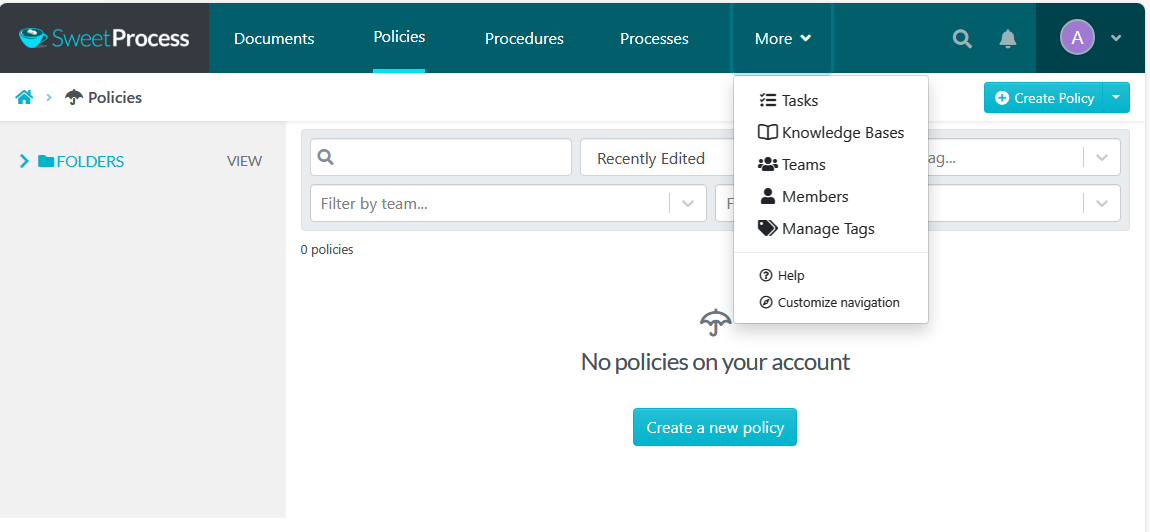
The “More” tab has additional options. Click on “Customize navigation” and this opens up:
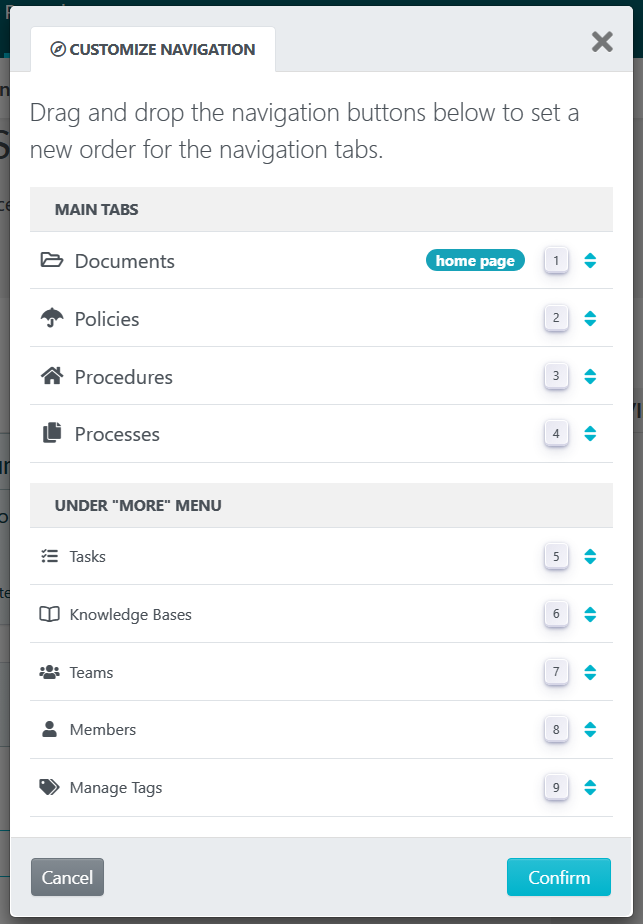
If you need frequent access to tasks, for example, you can drag it to the upper section so that it appears in the main navigation and remains always visible. Alternatively, you can drag one of the existing tabs (Policies, for example) to the lower section, and it will appear under the “More” dropdown.
Remember to click the blue button to save your customized navigation.
Using our software, you will get exactly what you need at any moment. There will be no redundant options to confuse or overwhelm you.
For example, something like this appears when you click on “Procedures:”

Click a procedure, and it will appear in viewing mode. If you wish to make any changes, you will need to make the procedure editable by clicking the edit button (which will be present at the top right of your screen at that time). This means you cannot make any accidental changes to the procedure while viewing it.
When you click any of the three vertical dots beside the procedure names, this pop-up menu appears:
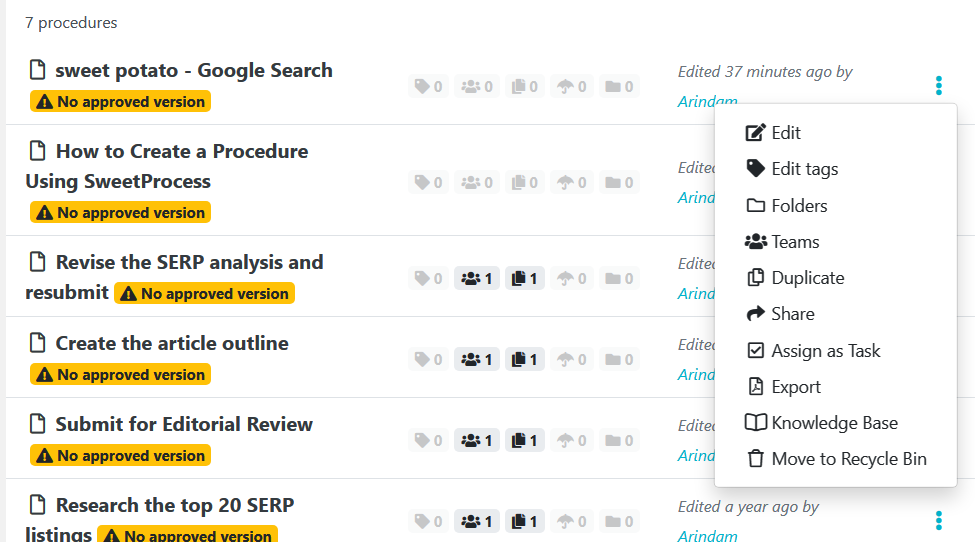
The options include everything you might have in mind when presented with a list of existing procedures.
Now let’s look at the options (from the “Actions” button) you get when you are editing the procedure.
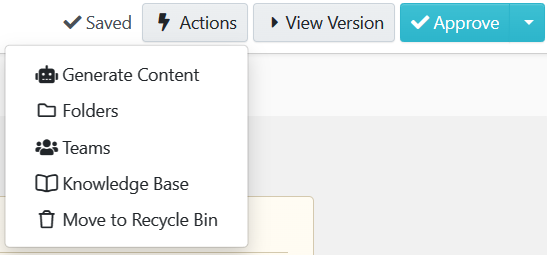
At the moment, you are editing a document, so this is all you get—which is precisely all you need.
Additionally, the “Version” tab now appears beside the “Actions” button, and there’s a blue button to the right for approval. You could check the version history of the document while editing it.
After you’re done editing, you must approve your version (or get it approved by someone if you don’t have permission) for it to go live.
- You cannot inadvertently edit a document while viewing it.
- Nothing gets published accidentally.
- No work gets done where you don’t see who did it and at what hour.
Given the sensitive nature of most of the documents in a law firm, we’re guessing you’ll find this level of accountability a welcome feature in whichever law firm management software you use.
Create Legal Policies, Processes, and Procedures
In this section, we’ll give you an overview of how SweetProcess simplifies your workflow even when there are multiple possible outcomes and associated options inside a policy.
SweetAI
You can use our artificial intelligence tool to create anything you like. In this case, we used a very basic prompt: Policy One. SweetAI identifies the prompt as generic and takes into account the “One” as relating to something primary or introductory in the context of policies.
So, it gives us a number of paragraphs on how we can start out with our policy documentation. The document can now be used as a guideline or edited to suit our specific requirements.
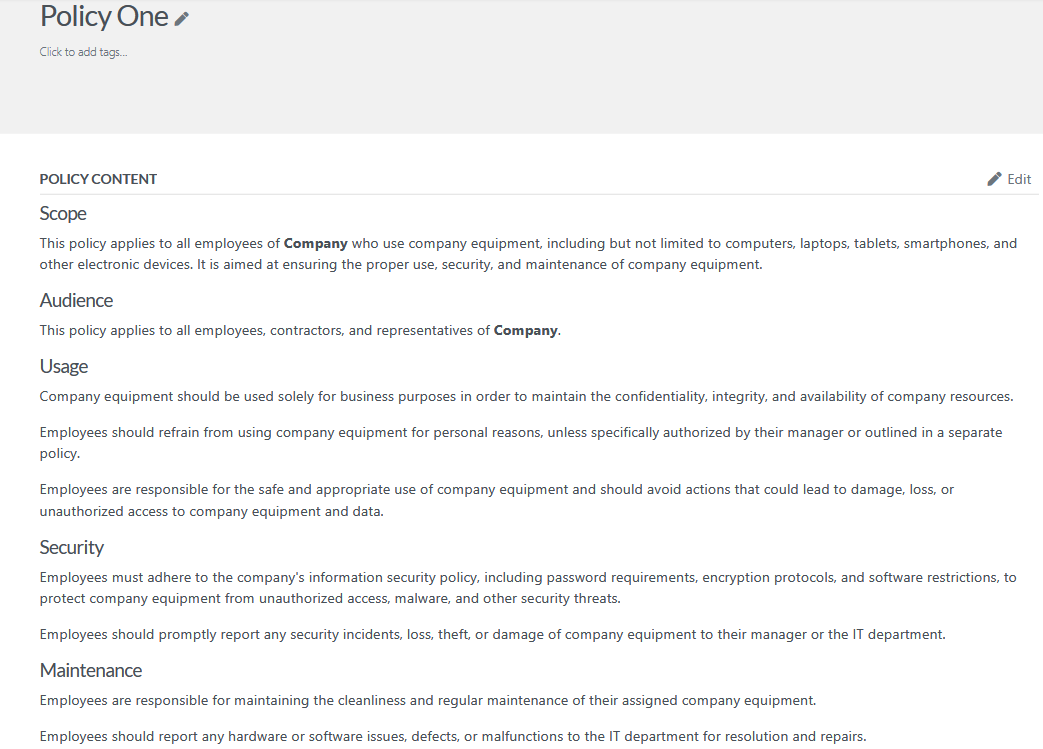
Mind you, this is the basic mode. You can connect SweetAI to its advanced mode by feeding it some information, and it tailors itself to your needs.
Please feel free to challenge our AI and let us know if you find any shortcomings.
A Simplified Workflow
Now, let’s show you how you can create a process. You must have existing procedures to insert into your process as “Steps.”
For creating a procedure or any document, the editor interface is almost the same. We have chosen our “Process One” to explain things because it shows everything in one place.
Look at the top right corner for the blue button to create a new document. Then, you will find the SweetProcess editor.
You can insert images, videos, links, and tables into any existing document.
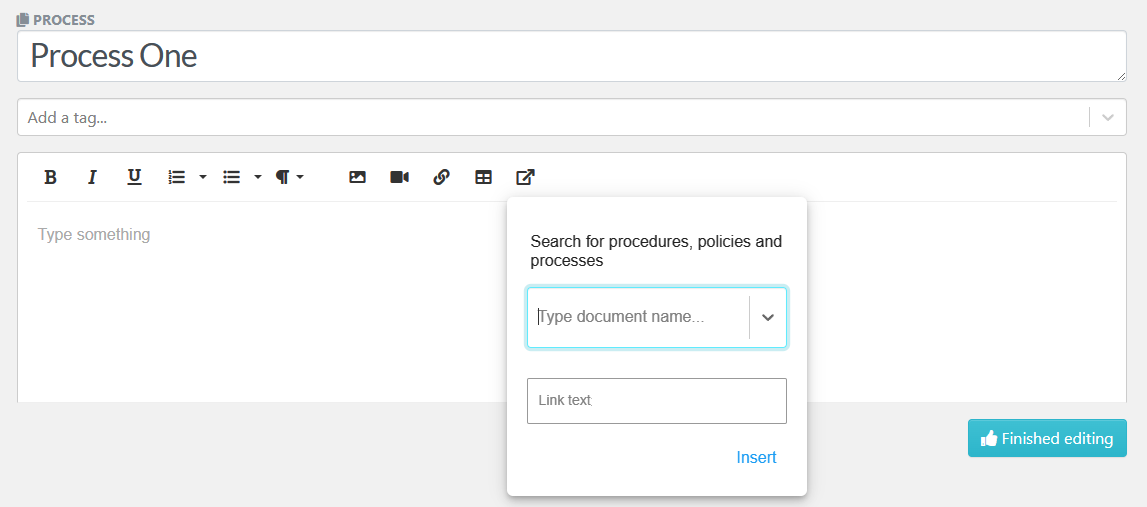
Please note the next image. Every segment enclosed within separators is a step with a blue circle and a white cross at the center. Hover over the blue circle, and the option to add a step appears. You can rearrange the steps using the “More” button on the right.
The gray “Overview” on the right is a process map that updates as you add steps.
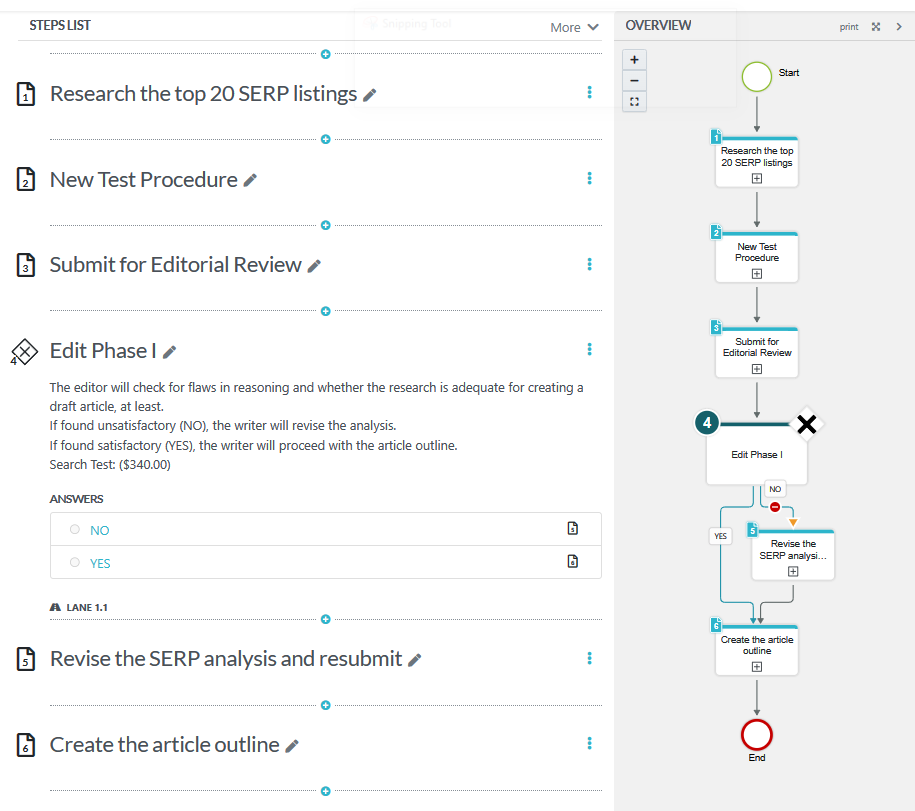
The “Overview” section can be turned on or off with a click. You can also zoom in or out and adjust its size on your screen.
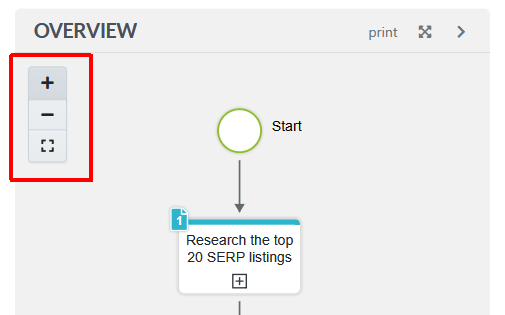
Clicking the expand (antique cross) icon next to “Print” will make this section appear on its own in portrait or landscape mode, depending on your viewport:

Want a hard copy? Use the print option to download/print a PNG version of the map.
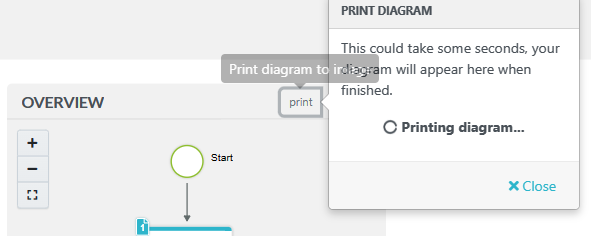
Do you think having all of this in the same workspace might affect your efficiency in some manner?
The Decision Step
When more than one outcome and consequent action is present in a single stage (or step) in a workflow, use the “Decision Step.”
Click the same blue button with a white cross for the Decision Step:
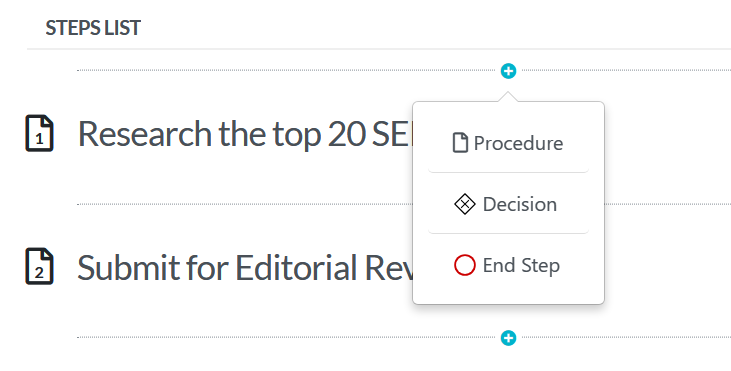
As you work on the Decision Step, the overview panel on the right reflects it:
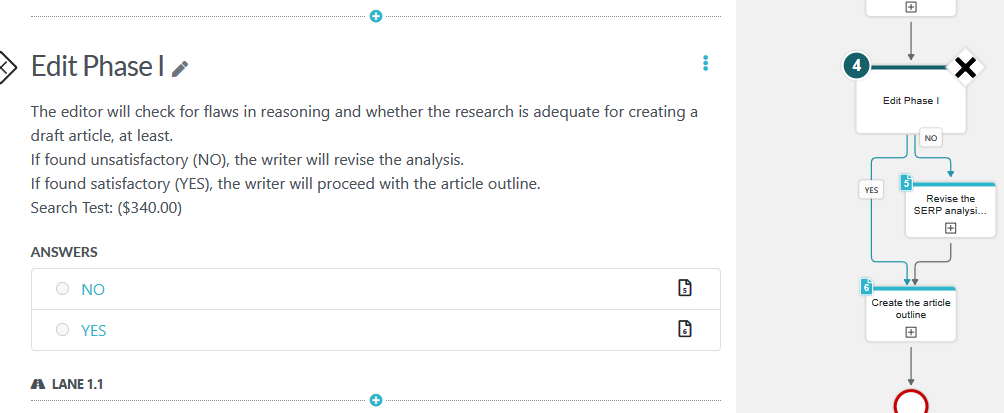
Now that we’ve shown you around let’s look at a few useful features before we wrap up this section.
Build a Quiz to Assess Your Employee’s Grasp of Company Policies, Processes, and Procedures
A quiz is non-invasive. Even though everyone knows this is an administrative check, a quiz should make them less apprehensive than something like a quarterly review where they have to answer a series of questions.
When you get to the quizzes page from the drop-down below the “More” tab, you will find all your existing quizzes listed or a message that there aren’t any on your account. You will also find two blue buttons to create a new quiz.
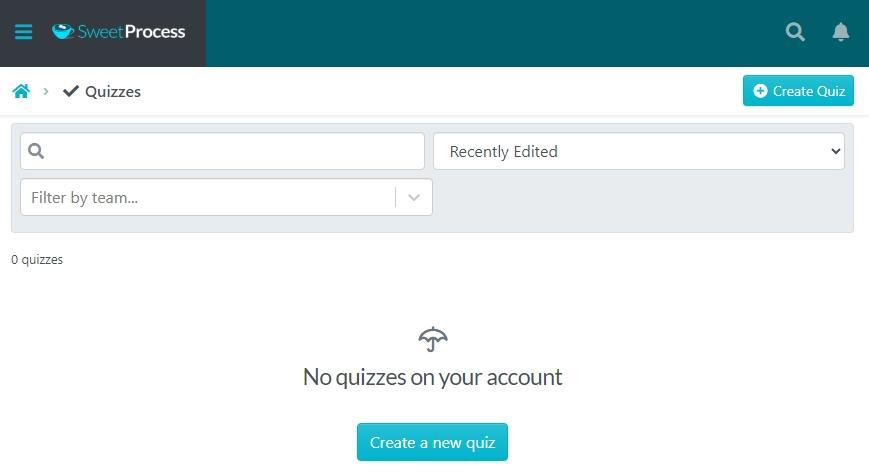
The following options appear when you try to create a new quiz:
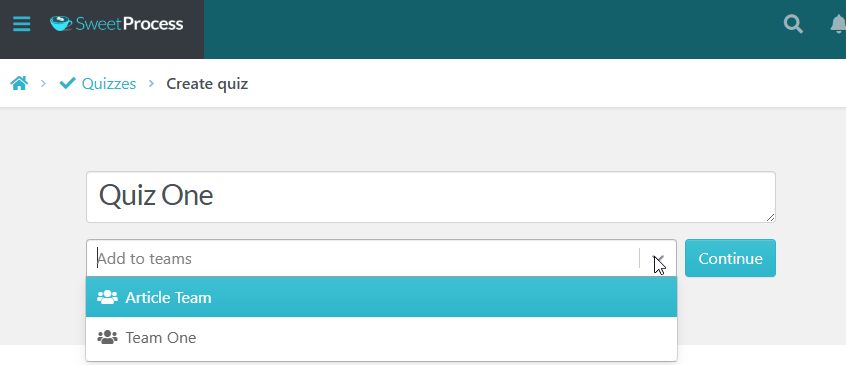
We have named ours “Quiz One.” Clicking the “Add to teams” option reveals your existing teams. Then, we click the “Continue” button to continue with the process.
In case you’re wondering, the “More” tab also has the “Teams” option in its drop-down menu. This is where you find yourself when you click the blue button to create a new team:
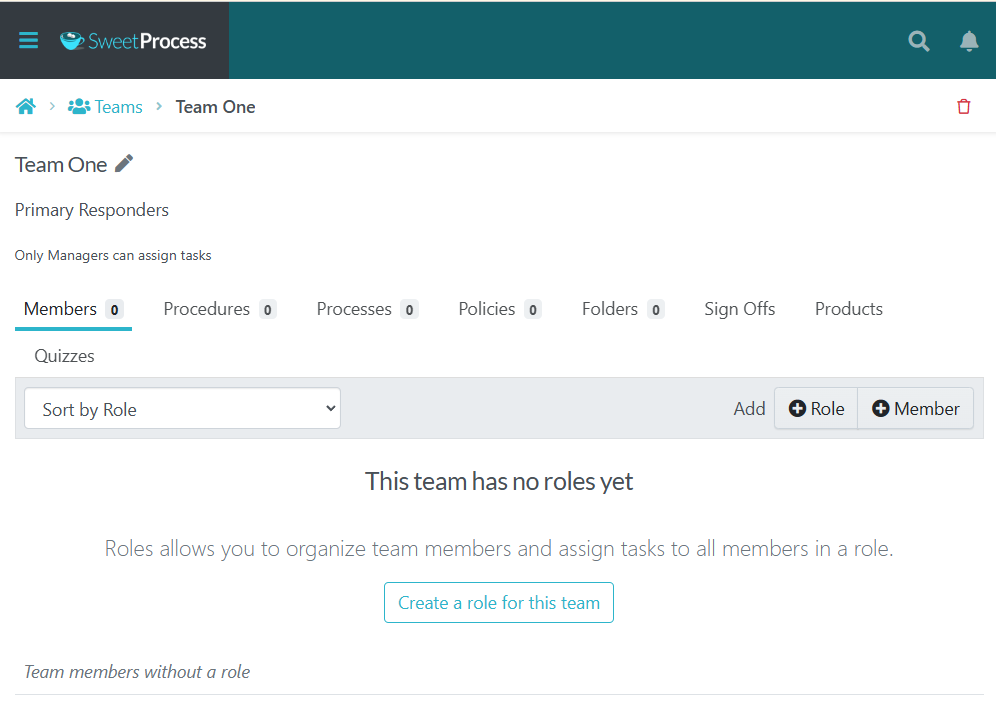
Then you click the “Member” option on the light gray bar for this pop-up, and that’s all there is to it.
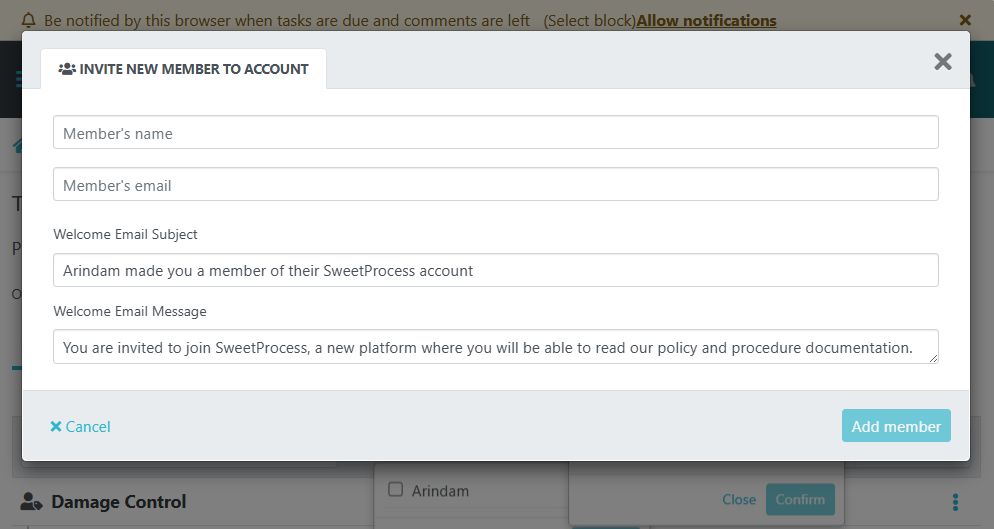
Find out for yourself if SweetProcess is as efficient and intuitive as we claim it is.
After clicking the “Continue” button, this is where we create the body of the quiz:
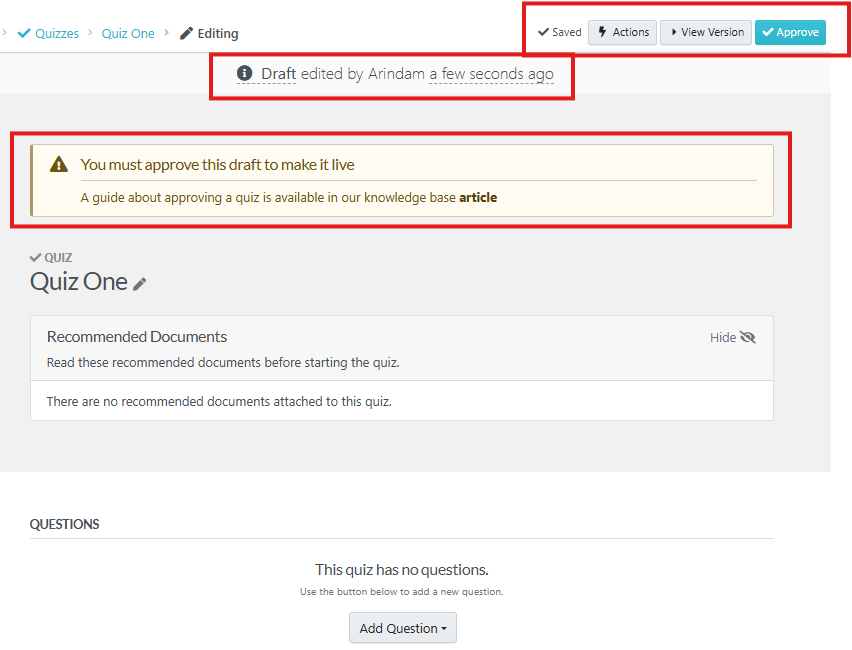
Let us take a moment to explain the options we have marked with red boxes.
- Note the saved message with a checkmark to the extreme left of the topmost box: We don’t leave you wondering if your work is saved. Since it is a message, it shows a white background, unlike the active blue “Approve” button to the right, which also has a checkmark before it.
- The largest red box shows that your saved work does not go live until it is approved. As the admin of your SweetProcess account, you can grant approval access to whoever you wish.
- The red box (second from the top) shows who edited the quiz and when. If you want to view the entire history of all edits ever done to the doc, click the “View Version” button at the top right beside the “Approve” button.
Tracking the work your employees do is effortless.
At the bottom of the image (with the red boxes) is the “Add Question” option. Click that button, and this appears:
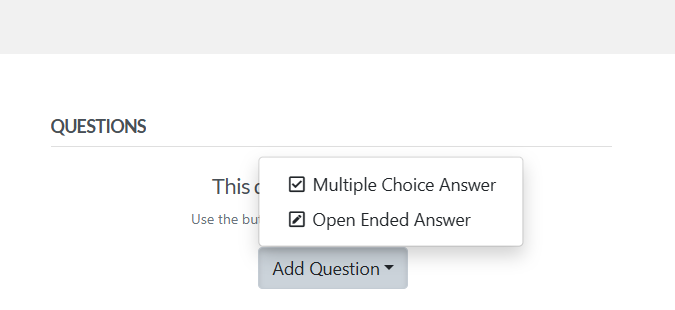
If we go with the “Multiple Choice” option, this is what we see next:

Clicking any of the two option fields opens our main writing/editing tool:
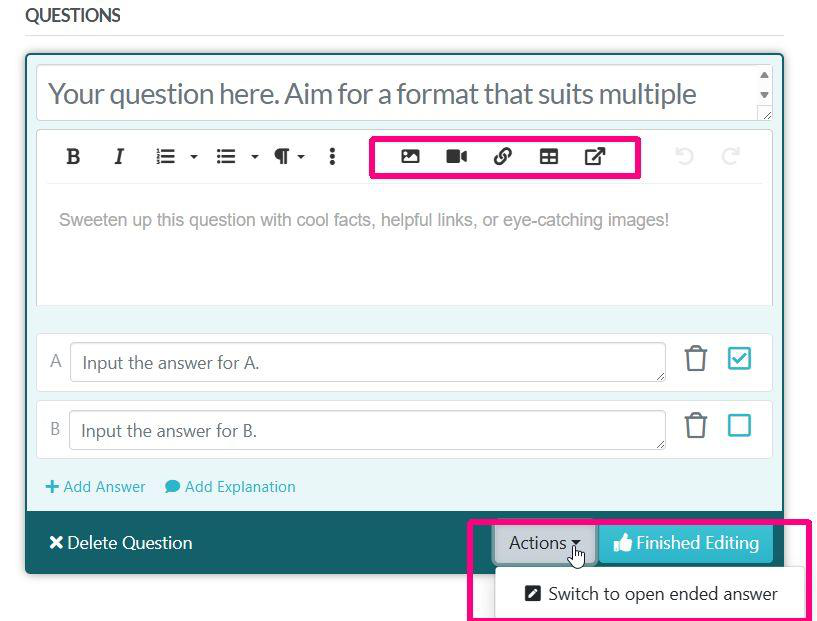
The icons marked in red at the top right are (from left to right) for inserting images, videos, links, and tables. The last icon lets you link any existing policy, process, or procedure.
With the “Action” button at the bottom, you can instantly switch the format to an open-ended question option without starting over. Convenient, right?
Here are a few more options and how to use them for your quiz.
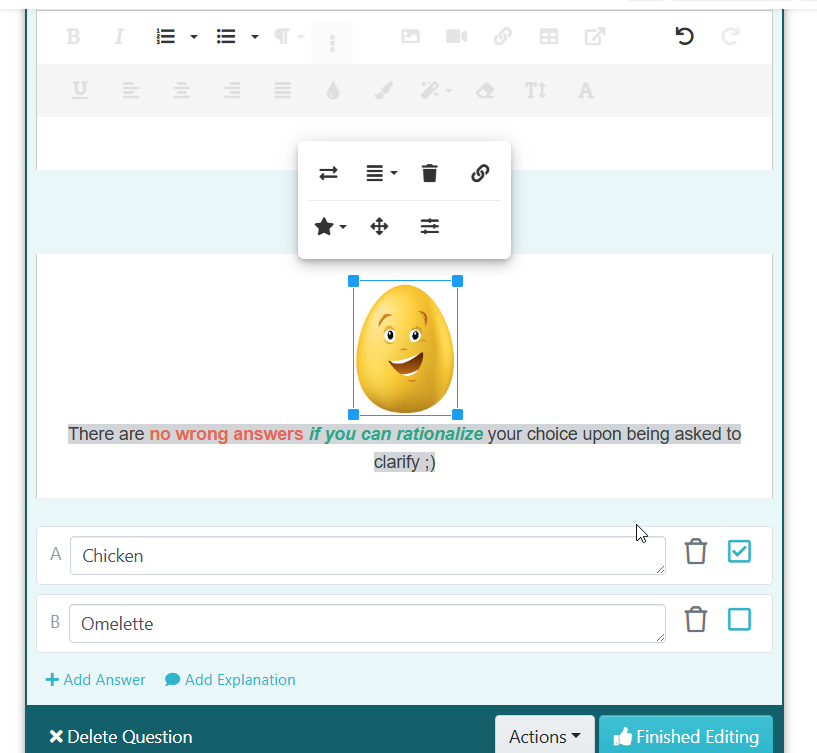
The (egg) image options are active, but almost every other option has grayed out.
We have used a background color with our bold and italicized colored text. The image is resizable, of course. You can add a video along with the image, tables, or link to some article that needs to be read to answer the question. The possibilities may not be endless, but they are undoubtedly extensive.
Turn Existing Legal Procedures and Policies into a Knowledge Base for Employees
If you go by the subhead, this works backward: We choose a knowledge base (or create one) and import the procedures and policies into it. Let’s show you how simple this really is.
So, you go from More Tab > Knowledge Bases > Create Knowledge Base (that blue button again).
Now, you’re on a page with various options about the kind of knowledge base you can create.
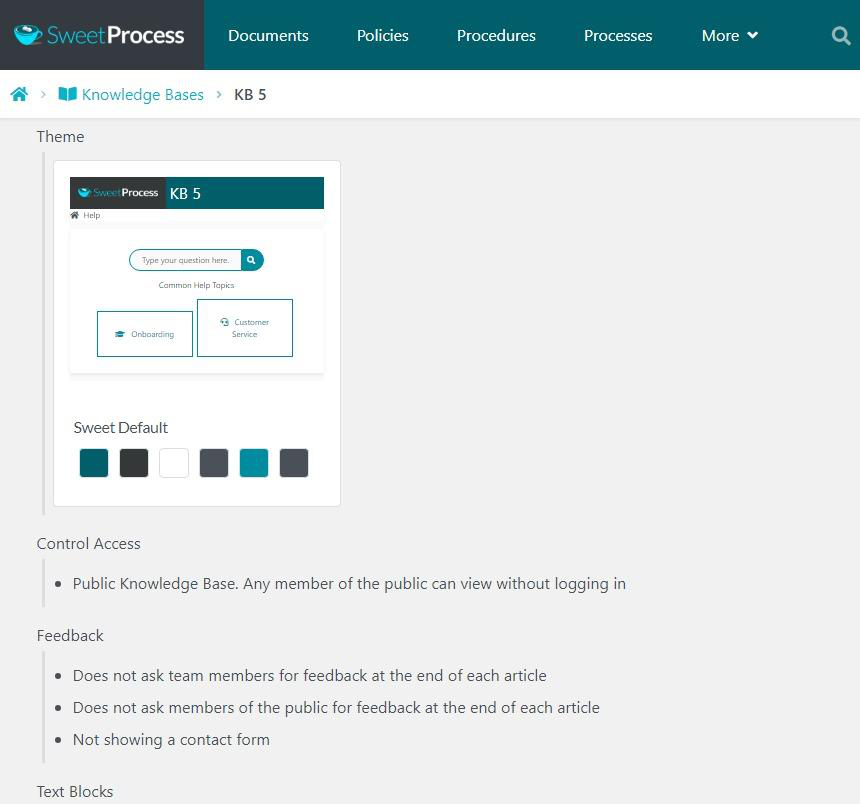
Below is the default “Control Access option, Public Knowledge Base.” Clicking on that will open an option field (see image below) from which you can choose “Private Knowledge Base.”

With the private knowledge base created, you may check or leave unchecked the option to receive feedback on the content your employees will view.
After this, you create a category, and then the category options will appear, among which is ‘Add New Article:”

When you click to add a new article, all your policies and procedures will appear in a drop-down and you can select whatever you want and then click the blue checkmark top right to finalize your selection.
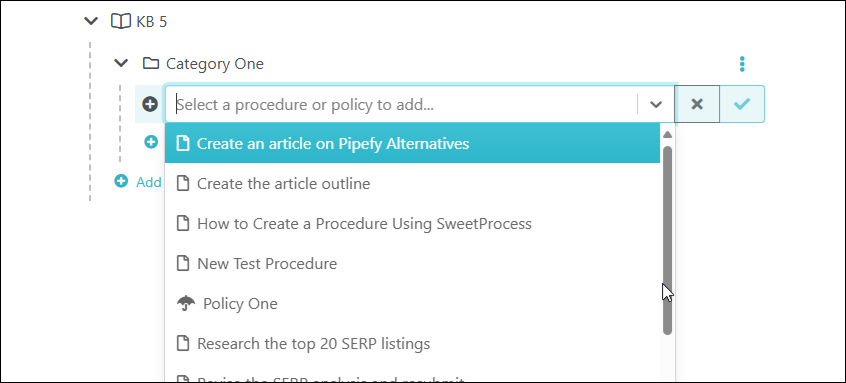
What if You Need to Import Your Policies and Procedures From Elsewhere?
Well, in that case, send us your existing documents or even hard copies, and we’ll do what is required—for free!
Don’t worry. We have imported completely unorganized and practically unwritten procedures into SweetProcess while one client, a ten-year-old company, continued its operations without a hitch, shifting from Denmark to Florida and turning from a sea-based to a land-based business. By “operations,” we mean salmon farming — you can read all about it here.
Turn Legal Procedures and Processes Into Actionable Tasks
This is as simple as can be, and we’ll illustrate with procedures.
- Click on “Procedure” (top nav menu) and find all your procedures listed.
- Click the three dots to the right of your chosen procedure.
- Choose “Assign as Task” from the menu that appears.
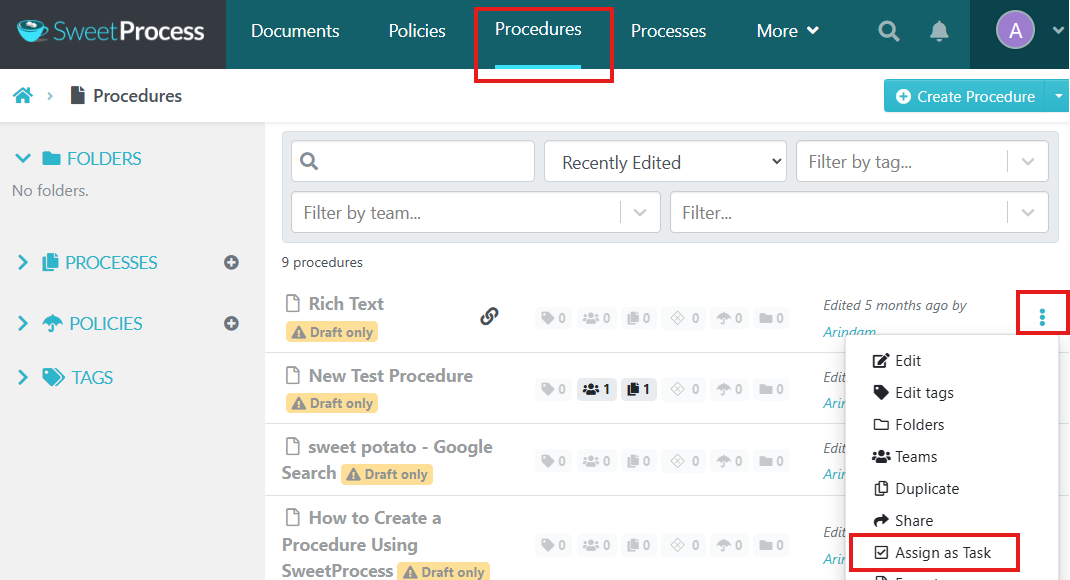
This is what you find when you are assigning the task:
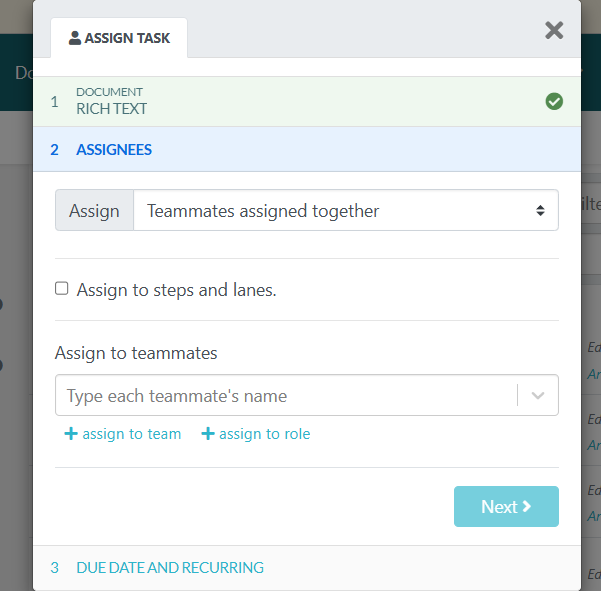
The due date option at the bottom becomes active when you insert at least one name in the “Assign to teammates” field.
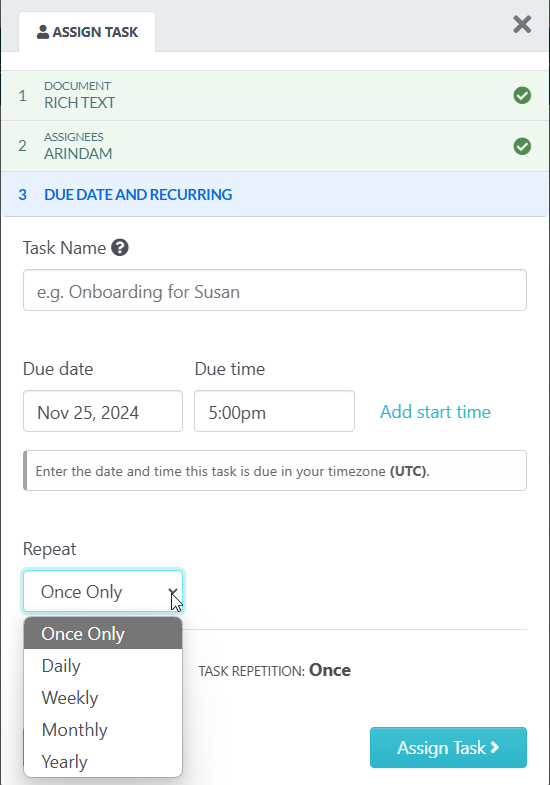
Assign Tasks and Collaborate With Your Legal Team Members
By default, only manager-level users can assign tasks. However, if a team is working on a single project, they must collaborate, pass tasks back and forth, and work continuously without asking for permission every two steps.
The solution is the option “Regular members assign tasks to other people.”
Note the part boxed in red at the top right in the image below. Click on your account and choose “My Account” to get to the account overview section.
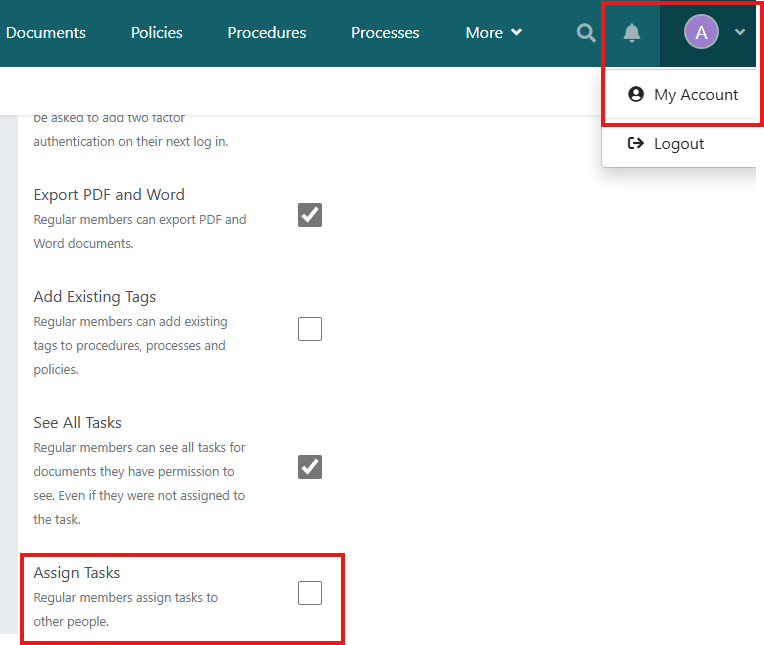
Scroll down, select the option in red, and now the entire team can assign tasks to each other.
Make Accounting (and Everything Else) Effortless
SweetProcess does not replace your accounting software.
What it does is make your accounting easy by organizing the data.
Let’s hear it from Candice Burgess, practice manager, 3rd Arm Admin:
“Payroll is one of the biggest services that we provide. We pay nearly 1,500 people a month across all the businesses that we do that for. One of the first projects of mine was to get all those payroll processes written up and put into SweetProcess… SweetProcess made that easy because of its step-by-step process that allows you to put in pictures and images.”
Did we hear her say, “SweetProcess made that easy…”? Sure we did.
Our system appeals to people who aren’t new to documented processes. Laura Johnson, admin/HR at the Brooks Law Group, explains:
“Employees were more dependent on me, even though it was on the server. They would have access to processes, but they would still lean more heavily toward me concerning questions and directives in some things…“
You can imagine how the workflow would suffer on days when Laura was absent to address the myriad queries.
The existing documentation wasn’t good enough if Laura’s absence invariably led to an interrupted workflow. The decision to switch to SweetProcess was taken based on a demo we showed them. “I don’t remember there being any difficulty in purchasing and implementing,” says Laura.
Brooks Law Group simply migrated their existing documentation into SweetProcess and reformatted them SweetProcess style. In their words:
“Switching to SweetProcess simplified our systems, made us more uniformed, and gave us easier access being a cloud place where we could go at any time. It’s structured and productive.”
For Laura, as well as for everyone else, it was “liberating.” She could take breaks without a worry. Her employees could look up SweetProcess for the answers to their queries.
How to Measure Success in Law Firm Management

This is a topic that requires a separate article. However, the present one would remain incomplete if we didn’t at least refer in passing to how to understand if what you’re doing is getting you real results.
Do not make the mistake of measuring profit as your main focus. You are running your business for profit, and it feels great when the figures look good, but what you primarily need is consistency and growth.
The following metrics are among the major ones that will tell you whether your law firm needs some tweaking in the management department:
- Revenue growth metrics
- Client retention rates
- Employee satisfaction scores
- Operational efficiency KPIs
The first one is a no-brainer. Or is it? Are you happy with your work-per-hour revenue? Best check your billables and see if they are really as good as they look on paper.
Client retention is almost equally important as revenue growth. It builds your brand, enhances your reputation, and brings in more clients. Any law firm management effort absolutely must prioritize onboarding, closing, and nurturing clients.
After all that gushing, we should also mention that sometimes you may need to cut some of them loose if they repeatedly do not align with your ethics.
Employee satisfaction score is important not just for workplace efficiency but also for further recruitment. If you’re low on this, prestigious universities may withhold their graduates from you or, at best, send reviewers for an appraisal, which could be an official embarrassment.
And finally, the Key Performance Indicators (KPIs) for operational efficiency — these are equivalent to the real-time progress of your firm. We mentioned overheads earlier. That is an example of operational KPI: How much are you spending daily just to keep everything running?
Well, it could be daily or monthly—doesn’t really matter, just so long as you don’t forget to account for the things most people take for granted, like power and wifi, for example.
Operational KPI is such an extensive area that we can hardly cover it in a paragraph or two. However, it would be a shame if we did not mention something closely related to what we listed at number one (revenue growth metrics).
Accounts receivables turnover is a measure of what you have actually received out of what you were supposed to receive. Without this metric, your calculation of revenue will remain misleading at best.
Manage Your Legal Firm Effectively Using SweetProcess

We mentioned various essential features that you’d look for in a tool that manages your law firm and its legal services effectively. We discussed and illustrated most of those except for this one:
What do you do when things go south?
For a law firm, not being able to respond immediately to your client’s plight would not only hurt the client but your reputation as well.
We love our features and take special care in monitoring and growing our platform to make it efficient and reliable.
Thankfully, because of years of consistent service, we are fortunate to have our customers speak for us:
“I have to say that the SweetProcess team has been really supportive. When we’ve had certain little features that we felt might help us out a little, they’ve been right on board in making slight tweaks—helping us rearrange the structure of how we’re using it so that it’s more accessible and easier to use.”
(Stone & Wood, Australia)
We believe in building relationships.
If you buy our plan, there’s an unconditional refund option for the first 30 days.
Included with that is a one-hour consultation free of cost as a parting gift.
